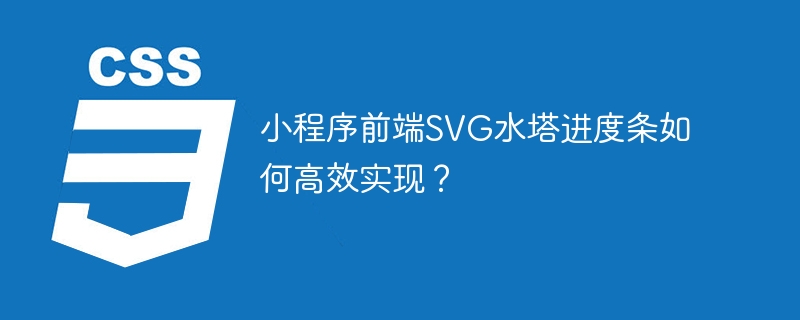 Web Front-end
Web Front-end
 CSS Tutorial
CSS Tutorial
 How to efficiently implement the SVG water tower progress bar in the front-end mini program?
How to efficiently implement the SVG water tower progress bar in the front-end mini program?
How to efficiently implement the SVG water tower progress bar in the front-end mini program?

Mini Program SVG Water Tower Progress Bar: Detailed explanation of efficient implementation plan
This article discusses how to efficiently implement a dynamically changing SVG water tower progress bar in the applet environment and provides the best solution.
Objective: Create a water tower SVG graph whose water level is adjusted in real time according to the progress value. When the progress is below 20%, the water level will be red; otherwise it will be green. The water tower size must be adapted to the parent container size.
Two inefficient solutions:
- Multi-picture switching scheme: Prepare multiple water tower pictures corresponding to different progress in advance, and display the progress by switching pictures. This solution package is large in size and has poor flexibility.
- Image Clipping Scheme: Use two pictures to simulate water level changes through
clip-pathclip-cut upper pictures. However, theclip-pathpath is fixed, making it difficult to achieve adaptive adjustment.
Best solution: Directly operate SVG code
In the applet environment, the best solution is to directly operate the SVG code. The steps are as follows:
- Read SVG files in binary: Use binary method to read SVG files to ensure that they are displayed correctly in iOS environment.
- JavaScript dynamically modify SVG properties: find and replace the attribute values in SVG that control water level height and color through JavaScript. For example, modify
<rect ... height="104" width="64"></rect>heightattribute value in the adjustment of the water level height, andfillattribute value is modified to change the color (less than 20% is red, otherwise it is green). - SVG to base64 encoding: convert the modified SVG code into a base64-encoded string.
- Load to image tag: load base64 string to
<image></image>Shown in the label.
Web-side development can directly use JavaScript variables to control SVG properties without base64 conversion.
The key is to find and modify the SVG attributes that control the height of the "mask". The SVG code examples provided by the article include height and color attributes, which developers can modify and adapt according to. This solution effectively avoids a large number of pictures, reduces the volume of the package, and realizes adaptive adjustment of the water tower size.
The above is the detailed content of How to efficiently implement the SVG water tower progress bar in the front-end mini program?. For more information, please follow other related articles on the PHP Chinese website!

Hot AI Tools

Undresser.AI Undress
AI-powered app for creating realistic nude photos

AI Clothes Remover
Online AI tool for removing clothes from photos.

Undress AI Tool
Undress images for free

Clothoff.io
AI clothes remover

Video Face Swap
Swap faces in any video effortlessly with our completely free AI face swap tool!

Hot Article

Hot Tools

Notepad++7.3.1
Easy-to-use and free code editor

SublimeText3 Chinese version
Chinese version, very easy to use

Zend Studio 13.0.1
Powerful PHP integrated development environment

Dreamweaver CS6
Visual web development tools

SublimeText3 Mac version
God-level code editing software (SublimeText3)

Hot Topics
 Vue 3
Apr 02, 2025 pm 06:32 PM
Vue 3
Apr 02, 2025 pm 06:32 PM
It's out! Congrats to the Vue team for getting it done, I know it was a massive effort and a long time coming. All new docs, as well.
 Can you get valid CSS property values from the browser?
Apr 02, 2025 pm 06:17 PM
Can you get valid CSS property values from the browser?
Apr 02, 2025 pm 06:17 PM
I had someone write in with this very legit question. Lea just blogged about how you can get valid CSS properties themselves from the browser. That's like this.
 A bit on ci/cd
Apr 02, 2025 pm 06:21 PM
A bit on ci/cd
Apr 02, 2025 pm 06:21 PM
I'd say "website" fits better than "mobile app" but I like this framing from Max Lynch:
 Using Markdown and Localization in the WordPress Block Editor
Apr 02, 2025 am 04:27 AM
Using Markdown and Localization in the WordPress Block Editor
Apr 02, 2025 am 04:27 AM
If we need to show documentation to the user directly in the WordPress editor, what is the best way to do it?
 Stacked Cards with Sticky Positioning and a Dash of Sass
Apr 03, 2025 am 10:30 AM
Stacked Cards with Sticky Positioning and a Dash of Sass
Apr 03, 2025 am 10:30 AM
The other day, I spotted this particularly lovely bit from Corey Ginnivan’s website where a collection of cards stack on top of one another as you scroll.
 Comparing Browsers for Responsive Design
Apr 02, 2025 pm 06:25 PM
Comparing Browsers for Responsive Design
Apr 02, 2025 pm 06:25 PM
There are a number of these desktop apps where the goal is showing your site at different dimensions all at the same time. So you can, for example, be writing
 How to Use CSS Grid for Sticky Headers and Footers
Apr 02, 2025 pm 06:29 PM
How to Use CSS Grid for Sticky Headers and Footers
Apr 02, 2025 pm 06:29 PM
CSS Grid is a collection of properties designed to make layout easier than it’s ever been. Like anything, there's a bit of a learning curve, but Grid is
 Google Fonts Variable Fonts
Apr 09, 2025 am 10:42 AM
Google Fonts Variable Fonts
Apr 09, 2025 am 10:42 AM
I see Google Fonts rolled out a new design (Tweet). Compared to the last big redesign, this feels much more iterative. I can barely tell the difference





